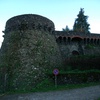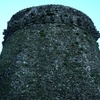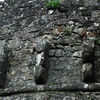Fort of Camporgiano
Camporgiano was the seat of one of the major vicariates of Garfagnana, which, for a short period, consisted of about fifty communities. The fortress of Camporgiano, controlled most of the Serchio and Edron valleys. Moreover, the fortress was also able to stay in visual contact with numerous locations, such as military facilities present at Verrucole and San Romano.
The fortified walls are preserved almost in their original form, with high curtain scarping topped with a string course and still much of the original system of corbels. The two towers are almost identical, constructed exactly like the walls with high scarping, a string course and hanging arches. The gateway is a single opening of a sandstone arch.
Of note, in the nearby Church of St. James, you can find a precious panel dating from the fourteenth century depicting the Madonna and Child by the Master of Camporgiano.
The excellent condition of the fort of Camporgiano, which still retains much of its defensive structures, is ascribed to the interest of the House of Este. As one can deduce from sixteenth-century maps, it had a double circuit of fortified walls. The outer walls, still clearly visible, were structured on a fairly regular basis. Formed on the north, south and west by straight curtaining, the east side is polygonal. The north-west and south-west corners feature two imposing circular towers overlooking the only gateway.
Historical notes
In addition to the defensive walls in the north-east portion, one last item was a defense tower with a quadrangular base disposed within the inner perimeter. In the space between the two curtain walls some facilities were positioned, such as a small single-nave and apse chapel.
Castle Camporgiano until the eleventh century was ruled by the Cattani family related to the Bishop of Luni, later found itself at the centre of a complex web of feudal rights, laity and clergy and was subjected to constant transformations. Only in the thirteenth century did the Republic of Lucca became the undisputed ruler of Camporgiano, as evidenced by the presence of a vicariate of Lucca within this community. However, in 1434, the vicariate fell to Spinetta Malaspina and then to the Florentines who possessed it until 1446, when Leonello d'Este was able to convince a large number of the inhabitants of the community of Garfagnana to deliver it to his control. The fort, certainly of very ancient origin, was rebuilt during the Guinigiana era and extensively altered during that of the House of Este, having been designated as the seat for the delegate of the ducal government.











